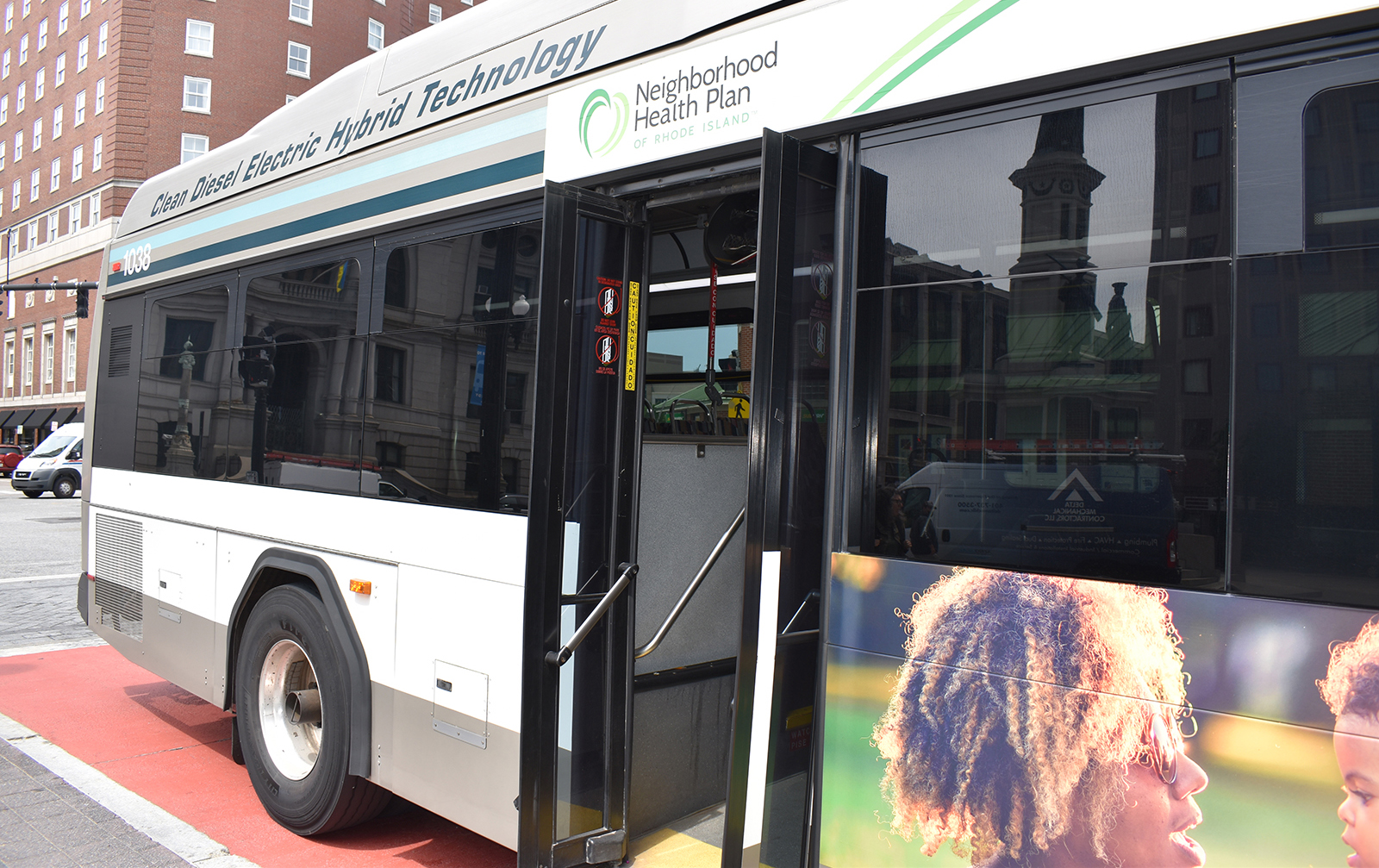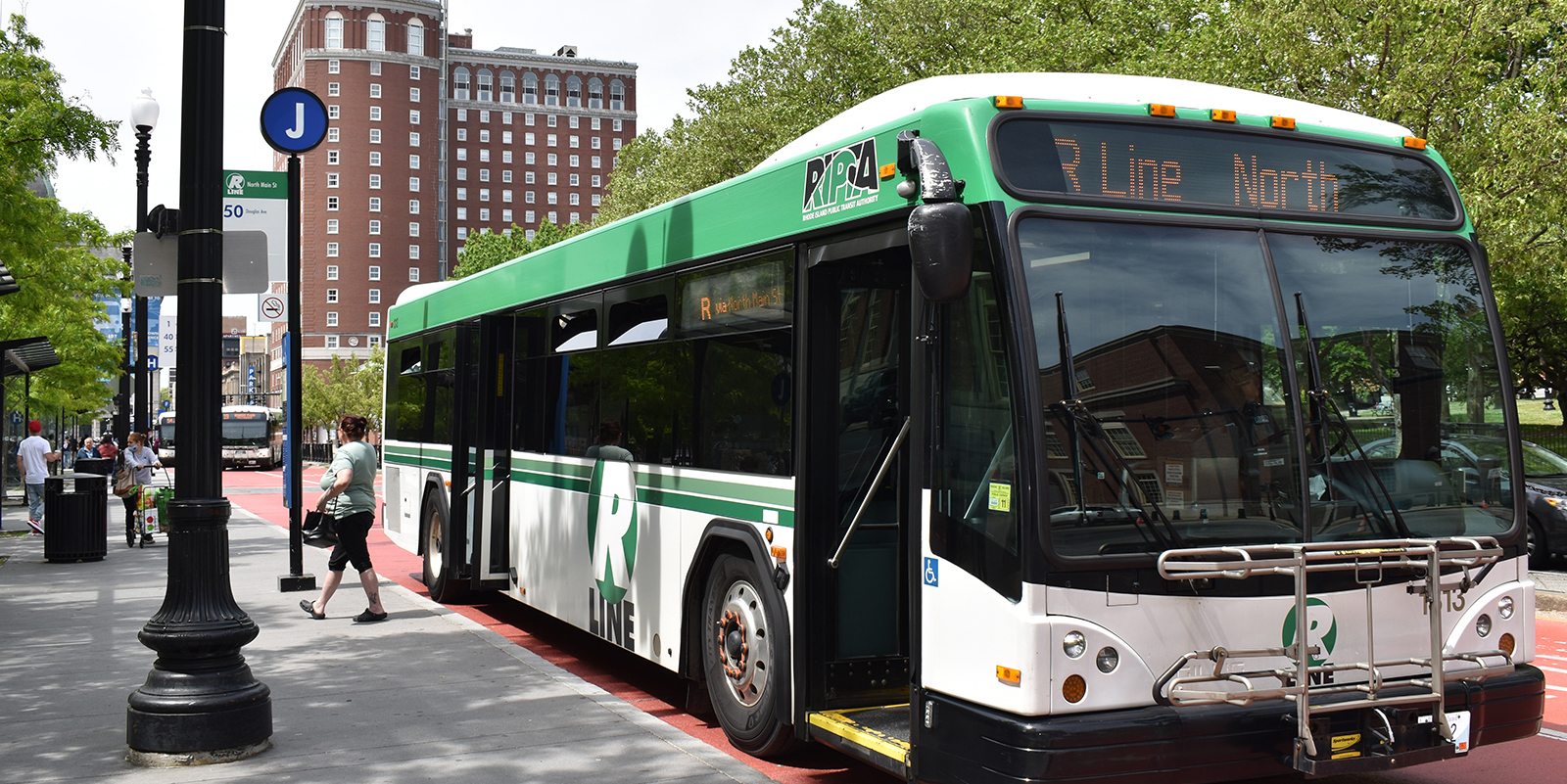Supporters Want E-Bikes Allowed on R.I.’s Bicycle Paths
May 8, 2023
PROVIDENCE — Cycling advocates and business owners got their chance to wheel and deal with legislators last week.
On May 4, the Rhode Island Bicycle Coalition (RIBC), with representatives from local bike shops, hosted a demonstration on the lower Statehouse parking lot to show elected officials all about electric bicycles, or e-bikes, and give them a chance to ride one.
RIBC president Kathleen Gannon told ecoRI News the event was aimed at dispelling some of the misinformation or presumptions people have about e-bikes.
“People don’t often understand what e-bikes are,” Gannon said. “Today they can get a chance to look at them and try them.”
E-bikes are bicycles that come equipped with an electric motor — although, noted Gannon, they aren’t actually motors like those powered by gas — that help propel the bike when riding. The e-bike industry, following the lead of the U.S. Department of Transportation, classifies them into three distinct classes based on how the motor assists the rider and the maximum speed a bike can go.
Class 1 e-bikes have pedal-assist, which means the engine only helps propel the rider while pedaling, and the function stops when the bike reaches a maximum speed of 20 mph.
Class 2 e-bikes come with throttle-assistance. Similar to motorcycles, the electric motor is activated by twisting a throttle on the handlebar. These bicycles are also capped at a maximum speed of 20 mph.
Class 3 e-bikes are similar to class 1, in that they rely on pedal-assistance to activate the electric motor’s assistance, but can reach a greater maximum speed of 28 mph.
E-bike batteries are located inside the bike, and on average have a range of 30-60 miles on a single charge, although a select few models come with the ability to mount a second external battery on the chassis to increase mileage.
Advocates say the electric motor is a game-changer for everyone, especially people who may have disabilities or medical conditions that prevent them from riding a traditional bicycle. The motor allows people to ride up hills they wouldn’t be able to normally under their own pedaling power, and to travel for longer distances.
In Rhode Island, e-bikes are technically illegal on bike paths as the state has no laws on the books regulating them, but their status isn’t usually enforced. Despite being considered bicycles, they are motorized vehicles in the state’s view. Rhode Island is an outlier; 40 states have passed the 3-class system as laid out by the federal government and e-bike industry.
Earlier this year Rep. Rebecca Kislak, D-Providence, introduced legislation (H5220) to regulate e-bikes according to the standards laid out by the U.S. Department of Transportation. It’s the second year in a row Kislak introduced such legislation.
During a February hearing, Kislak told members of the House Corporations Committee that she originally thought of e-bikes as “cheating” and did not understand the benefits they provide.
“I went for a ride with a friend who has a mobility impairment, and I couldn’t have gone on a bike ride with her without it,” Kislak said. “It was amazing.”
Not everyone shares that view. In written testimony, several East Bay residents expressed concern over allowing e-bikes on bike paths, citing an instance in 2022 when a Bristol man was struck by an e-bike user while riding his bicycle on the East Bay Bike Path.
“Trying to make motorized bikes equivalent to human powered bicycles on bike paths is a recipe for disaster,” wrote Bristol resident Judy Brynes in testimony to the committee.
Gannon disputes the safety concerns some people have about e-bikes, noting maximum speed limits prevent them from being less safe than traditional bicycles, which can exceed 20 mph downhill. Gannon said most people probably couldn’t tell the difference between an e-bike and a traditional bicycle without examining it up close.
“That’s just what these are,” she said. “They’re bicycles.”




Set a max speed of 15 miles per hour for E-bikes.
As someone who uses the bike paths regularly for jogging and bike riding with my young children, I find the use of E-bikes (aka. E-mopeds) on our recreation paths/bike paths to be irresponsible. These vehicles are mo-peds / motorcycles. They belong on transportation through-ways designated for higher speed transportation vehicles. We can all collectively agree that the “modified” or higher speed mo-peds should not be allowed on these recreation paths. Who is going to police which e-bikes are which? What will the punishment be if they are driving the wrong E-moped on our bike paths? Just outlaw them all together on our recreation paths and be done with it. Follow the money on this. We dont allow combustion engine transportation vehicles on our recreation paths – why would an electric engine transportation vehicle be any different? Safety should guide decision making on this. How is this even a debate?! Why do we require training and licenses for mo-ped, car and motorcycle drivers? Safety.
I ride on the Coventry trail with a manual bike and I have no issues with the electric bike riders around me. However, this change has actually brought very loud fuel loaded mini bikes onto this trail which nearly caused me to lose my balance and fall. So we need to enforce in detail what kind if bikes are allowed and not allowed here.
Legalizing EMBs (electric motorized bicycles) on RI bike paths will endanger the vulnerable users who have been enjoying the bike paths for over 30 years. This bill is being pushed by an industry coalition called People for Bikes as there is so much money to be made by cashing in our bike paths.
When the demo was held at the State House, (a possible impropriety in itself), the bikes presented bore little resemblance to the 70+ pound EMB bikes that are so heavy they need hydraulic disc brakes to stop them. This is what is now on the bike paths-heavy EMBs with motorcycle size tires that can go 30+ mph.
Why mix them in with vulnerable users like walkers and kids? As for energy savings, they are being operated on bike paths, not only as a substitute for cars, but much of the time they are replacing human powered bikes. How is this contributing to energy efficiency? There is also nothing in this bill about lithium battery safety or recycling, and nothing at all about enforcement. In fact local municipalities would be prohibited from enacting any restrictions although in reality, they are the ones who are the first responders. There is also no input in this bill from DEM or DOT as the prime stakeholders-the State Bike Path system is actually an administrative orphan in the state, even though bike paths, as linear parks, are part of the state park system.
This is a flawed bill which creates yet another unfunded mandate, as apparently DEM has no resources to ensure safety on the bike paths. Since that is the reality, why make it worse? The bill passed the House, has been heard in the Senate Judiciary Committee and is held for further study.
PS the e bike operator who crashed into the pedal bike rider gave the Warren Police a false name, address and phone number and has never been identified.
Judith A. Byrnes (note spelling)
Bristol, along the East Bay Bike Path
Spoken as a very capable and intense cyclist who is capable of a 20mph average century (that’s 100 miles people) an ebike is not a bicycle, it’s a motorcycle, period.
It took YEARS for me to not only attain the capability of riding 20mph consistently on flat surfaces but also the time to save up for a fast, capable bike that could sustain that performance for long periods of time as I could do so with most any bike but only a fast, expensive road bike for any appreciable amount of time. During that time I fell, got into near misses, took lessons, worked out, trained, tried difference disciplines, met many people, took up group riding and learned many things. It took a long time to earn the ability to reach high speed and I even now I feel the enormous effort my legs require to reach those high speeds. Even now that I can race at high speed and do so on a regular basis with various very fast groups I mostly avoid doing so on the bike paths and only go fast on roads just because of the danger in such mixed company of spaces normally reserved for human powered vehicles. Someone with an ebike can just…. fly along at 20mph all day long and that is absolutely dangerous!
With an ebike, any old fool can go do the store with the only necessary qualification is sufficient funds for the purchase and bring home that same performance that takes cyclists years of experience to attain but without the knowledge to tame that power. It’s just as bad as giving an inexperienced teenager a fast sports car as his first ride. I am not against ebikes per se, but vehemently opposed to their legally sharing the same space as the one and true bicycles: human powered ones. If you want to enjoy a motor regardless of the conveyance, YOU SHOULD BE SUBJECT TO MOTOR VEHICLE LAWS. You want an engine on two wheels, you should get a motorcycle license and follow all such laws.
The proposed law presented by Rep. Kislak is in fact the law in 39 of 50 states in the US, including both California and New York. It is the law for a majority of Americans today. The bike path discussion? Is a whole other matter entirely, I understand. If you can’t see the green-solution nature of having these devices added to augment the heavy-usage of gas-guzzling / polluting murder boxes (cars), then God help us all.
Lots of “get off my lawn” energy here. My colleagues in the UK get fully reimbursed by the government for their eBike purchase, and they commute in bike lanes alongside traditional bicycles. So far the sky hasn’t fallen. In fact, they arrive at work on time, having gotten some exercise but not so much that they need a shower. eBikes are a good thing.
I’ve ridden a bicycle and I’ve run on all the bike paths in Rhode Island for more than 20 years and have often been startled, threatened and almost knocked down by pedal-powered cowboys. I have witnessed a pedestrian-bicycle collision that sent the pedestrian to the hospital. Some people don’t know how to share the road, no matter what they’re riding. The issue isn’t eBikes, it’s riders of any bicycle who think they own the road, and anyone slower than they are should just get out of their way NOW.
Okay, if it’s acknowledgement that you’re the better person, more skilled and in better physical shape than the slobs on eBikes that you want, fine, here it is, wear a T-Shirt proclaiming your superiority. I don’t care. Just share the path with me. I want to continue enjoying the bike paths as I age, and eBikes allow that.
My car can exceed 100 MPH but I don’t. My e-bike can travel at 20MPH but I don’t . Due to age deterioration I can walk maybe 100 yards before I am in severe pain. Riding my e-bike in traffic terrifies me. A cyclist riding at his best speed is just as dangerous to pedestrian traffic as an e-bike rider. The only difference is their arrogance.
Saying E-Bikes should be outlawed on bike paths is small minded, and quite frankly discriminatory. I’m 61 years old with arthritic knees. While I could never hope to ride a standard bicycle for any significant distance or up even the smallest incline due to my knees, I am able to ride the trails with my e-bike with no ill effects. While on the trail I keep my speed under 15 mph, and I very frequently have athletes on “standard” bike blow past me like I’m standing still. Perhaps we should outlaw athletes on the bike paths as well? I also often get passed by standard bikes going downhill, so while we’re at it, let’s prohibit hills on bike paths as well.
I’m not saying this does not require regulation, it does. And yes, there will always be yahoos that go blazing down the trail at 30+ mph with no regard to their own safety at the safety of others. After 2 years of riding the trail regularly, I can say with absolute certainty that these people are BY FAR the minority. The vast majority of e-bike riders on the trails are people like me, elderly people or people that are physically challenged and could not ride the trails otherwise. No, outright banning them is not the answer. For one thing it won’t solved the (perceived) problem. Do you really think issuing a law banning e-bikes from trails will keep the yahoos away? People with no regard for safety rarely have much regard for the law. The people you’ll be keeping away are the elderly and the physically challenged, which is why I say such a law would be discriminatory.
What we need are regulated speed limits on the trails. My car is capable of driving over 100 mph. Does that means I’m not allowed to drive it in a 25 mph zone? No, of course not. I’m expected to control my vehicle and drive it within the stated limits. The same should be applied to e-bikes on the trails. Set a speed limit, and expect people to control their vehicle and operate it within the stated limits. And before you say “Well people won’t obey the limits”, or “It’s not enforceable”, I say the vast majority of e-bike riders already ARE riding their bikes safely on the trails, many under 15 mph and almost all under 20 mph. As for it’s not enforceable, well if that’s true then banning them wouldn’t be enforceable either. And either way, if you violate the rule, you’re breaking the law. It’s just that one rule allows people like myself, who just want to join in the fun and always operate their bike safely to join in the fun. The other rule puts me back home in my living room, watching TV and wishing I lived in a society that didn’t fear change so much. Think about it.